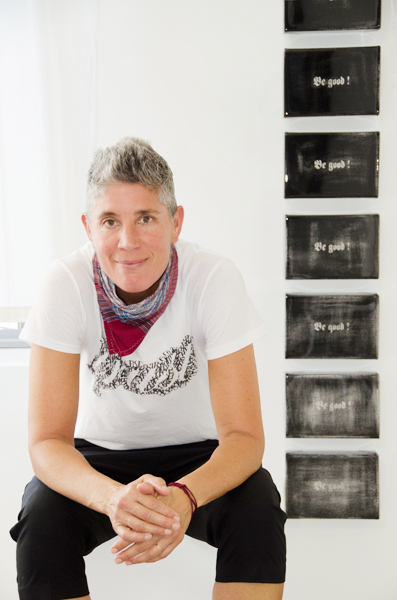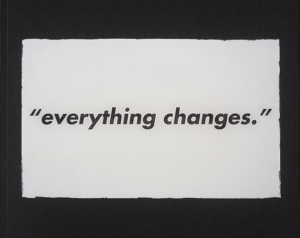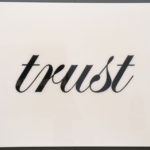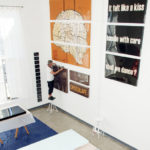Getting Lucky – a feature in Left Magazine
By David Helton
Photography by Jeff Kaluzny

There is something profound in the simplicity of her pieces. A massive, sixty by ninety inch canvas with the phrase ‘I just want to be loved’ neatly centered. The scale of the piece gets your attention; and then Lucky tells you something intimate. It’s unexpected.
Lucky Rapp is both strong willed and decisive, but she’s also vulnerable and sensitive. She’s adventurous and hardheaded. She likes to learn her lessons through her own experiences and she likes to share those lessons with her art. “It’s like glass.” She says about her technique. ‘There is something very fragile about it. I think that’s why I’m drawn to it – it’s strong, complicated and fragile all at the same time.’
Lucky Rapp is a San Francisco based visual artist with a background in both fashion and art. Her self-taught style is often characterized as being text-based. Her methodology incorporates layers of resin, paint and acrylic forms that create texture and depth within the dialogue of her work. Lucky’s approach is process-oriented and physical.
“It’s sort of where science and chemistry meet art.” She says.
The end result, combines inquisitive statements that play with both language and the potency of graphical commmunication, while the three-dimensional nature of the layered resin fosters a sculptural reflective quality.
Lucky’s work has been collected and exhibited across the United States and Europe, and has been featured in solo and group shows in Antwerp, Belgium and Mannheim, Germany, as well as in the United States at Andrea Schwartz
Gallery, Slate Contemporary Gallery, ArtZone 461 Gallery, Houston Art Fair, Los Angeles Affordable Art Fair, Campfire Gallery, and ARC Gallery.
Lucky’s work can frequently be found in the Roche Bobois San Francisco showroom and as an active member of the San Francisco art community she donates select works to the annual Art for Aids Auction, the Hospitality House Auction, and the ArtSpan Auction.
I met Lucky a few years ago through her sister, who I worked with. I was immediately fascinated with her. She laughs a lot. She smiles a lot. She’s a hard worker – and she’s thoughtful. When I learned that she was an artist, I could only say… of course she is. She has the spirit of an artist.
I caught up with Lucky in her new studio in Soma.
The fumes when you do this kind of work must be intense. Is it dangerous?
It can be. I wear a respirator. I have four of them actually, because I often need assistance when I do pours. We all have to wear the protective gear. When I first started working in this medium I would get these weird rashes on my wrists and on my neck, anything not covered up – I wasn’t smart in the very beginning. I was really naïve. I would use like a sanding mask, which did absolutely nothing [laughs].
What is this exactly?
It’s an epoxy coating with two parts. One part is a hardener and the other is a catalyst. But it starts to set quickly and sometimes you can see a last brush stroke if you don’t work quickly. You can create an imperfection.
Have you ever had a bad experience?
There was this one time I went in to the shop and said ‘Hey, the mixture was smoking.’ And the woman was like ‘Oh, yeah, that’s a bomb.’ I was like ‘What?!’ [Laughs] – It’s a bomb?! When you mix it you only have a few minutes to pour it. Otherwise it can combust. I have to concentrate. I can’t mess around or daydream. Once I answered the phone and I mixed part A with another part A. [Laughs] On a commission, 9 pieces no less! And I was screwed. It would never dry.
You didn’t know that?
No! I had no idea! [Laughs] I mean, it’s nowhere on the bottles. You would think they would put that somewhere on the bottle!? It doesn’t say it anywhere!
What I love about your work is that it looks like water. It’s like glass. It’s almost like it’s pressed from the back. It’s hard to believe that this is canvas.
You know, it’s actually a very repairable artform. If the whole thing cracked, I could pour something over it and make something else out of it. It has the ability to heal itself.
Your art is healing, literally!
Totally! It can repair itself and become something else if it’s ever shattered.
You need assistance to create the work?
I do need help on the bigger pieces; you have about ten minutes once you do a pour. After that, the resin starts to set and it’s impossible to work with. There are a lot of chemicals involved. It’s where science and chemistry merge with art. I think there is something really beautiful about that.
How did you discover this liquid resin technique?
When I came back from Europe, I was looking for these sealants that I had worked with in Germany. I worked for a company as a decorator and we’d do these homages to Andy Warhol and Keith Haring – very cool stuff. We’d use
house paint and then we’d seal them and the paint would shatter in this really unique and fantastic way, it created this antique effect that I was fascinated with. I was actually looking for that – but it was super toxic.
What is your work style?
I used to do this thing where when I was working on a big piece, I would listen to the same CD over and over and over.

Why?
I don’t know. It was like having a friend here I think. The work is lonely sometimes so I would play the same CD. It helped me to slow down time and stay in the same place for as long as I could. It’s like stopping time.
What did you listen to?
I listened to a lot of George Michael for some reason [laughs]. Man, I knew every song on the CD.
Do you like big pieces? Do you like to make this big statement?
I love big pieces. First of all, I love big pieces because I think that they’re high risk – and no risk in life means no fun in life. Because nobody has that kind of wall space in San Francisco. I did a giant piece that 60 x 90″ – which is massive – and it had very intimate things written on them.
Like what?
One said ‘I want to be a ballet dancer and I need you to believe me.” And another one said ‘I want to get to know you better and I need a chance and the time.” And another one said ‘Because I want to be loved.” In the Ballet statement you could change it out for almost anything. ‘I want to be a and I need you to believe me.” It’s about WANT and NEED – saying what you want and admitting what you need which is a very intimate thing to do. So not only is the piece itself physically imposing, the statement is almost like a secret. It’s like telling a secret really loudly. Like shouting your secrets. When my parents come in and look at this work, I always think ‘Gosh, what are they thinking.’ I worry they might be thinking that I need therapy. [Laughs]
What do your parents do?
My father is in real estate and my mother is an artist. In fact, she was pregnant with me while she was in art school at San Jose State. We’re all Bay Area born and raised.
Did you study art?
When I moved to Europe after I graduated from San Diego State, I had worked as a lifeguard and at Z Gallerie. [Laughs]
Remember when Z Gallerie was cool?
I had all these jobs. I worked at a diner. That kind of thing. Then I sold everything and went to Europe. I bought a one-way ticket to Paris. I don’t speak French. I have no idea what I wanted to what I was looking for – but that’s what I did.
You just went for it?
I went for it. I learned to speak French. I moved to Germany a year later so now I speak German with a French accent [Laughs] Nobody believes that I am American.
Did you come out to your parents before you left for Europe. How did that happen for you? My experience was horrible.
I was young. I was maybe twenty. Coming out was traumatic for me. I was on the tennis team at San Diego State and I had a girlfriend there. She had told me that if I didn’t come there for the summer, we were done – and we were on the phone talking and my parents overheard the conversation. I was horrified. I was also afraid and
unprepared to have this discussion. My Stepdad told me not to leave the house just as I was on my way out the door. My Dad came over and they sat me in a room and did this whole intervention thing [laughs] and they were like ‘You’ve been brainwashed!’ I was like, ‘Come on, you guys, are you really going to look at me tell me you never had a suspicion? Really? I found it hard to believe that they found it hard to believe that I was gay. I was on the tennis team for Christ’s sake! [Laughs]
But you had dated men?
I had boyfriends my whole life and because I was good at sports, guys really liked me. I really liked them – but I didn’t want to sleep with them. [Laughs] I connect differently with men. I admit that. I just don’t have a sexual attraction to men. I’m a lesbian.
Is it hard for women in San Francisco?
I don’t know what women in San Francisco do. Who knows. Right now I just work. I have a girlfriend in LA. It’s
a woman I dated when I was younger. We’ve sort of reconciled and come back together – and now that I’m older – It feels right. I really feel like I’m in love with her. [Laughs] I get to visit with her and I also get to come back and just submerse myself in my work. I like that. I need my solitude but I also need my time with her. I feel like it’s perfect.
You’ve had some bad relationships.
Oh, yeah. I certainly have. [Laughs] However, if someone in a relationship tries to hold on too tight, it usually doesn’t work for me. I like to be relaxed. I like to be able to do all the things that I need to do to be good for someone in a relationship, you know? I mean, if I am happy and I am being creative and I am making strong pieces – then I am happy and fulfilled and I am a whole person for my partner. If I am feeling miserable, I don’t want to bring that into someone else’s world?
I like to see you this happy with someone.
We trust one another. We love one another. I get to work. And when I see her, I am ecstatic. But I do spend a
lot of time alone. I need the solitude to think. It can be lonely but I think that a lot of creativity comes from being lonely. There is something magical about working here in the grey and the fog and the rain – and allowing myself to feel that.

You seem so adventurous.
I am adventurous but I am also fiercely monogamous. For me, when the trust is broken, I can’t go back. There is
no reverse on this car. [Laughs] I love being in love – and in my opinion, I don’t know how it is for guys, but I feel like sometimes women will stay in something unhealthy way longer than they should.
Gay guys do that too. I think everyone does sometimes.
If something is unhealthy and toxic, I am sensitive – I absorb that. I have to distance myself from that or I will be destroyed and I will be unhappy.
Who are some people that inspire you?
I just watched this wonderful documentary on Yves Saint Laurent. He was so brilliant and wonderful and awkward. He started designing at a very young age and he was successful. Because he didn’t have a childhood, later in life he started drinking and smoking and partying. In this documentary, someone asked him what he loved most – and he said ‘joy.’ He wanted to be joyful. But instead of finding joy, he just went downhill with his drug addiction.

Did you ever get involved with drugs and partying – living in San Francisco your whole life, you had to be surrounded by it?
It seems that a lot of creative people have that battle and that issue. You know, I made some bad choices in my life from time to time. I think we all have. However, I think you learn lessons and you ind your way back from that. It’s that journey and that strength that make us better people. I have so much compassion for people who can’t get out of that stuff. For me, I was an athlete so I wasn’t really into drinking and drugs. However, later in life I was exposed to that stuff and I didn’t know how to handle it. I was going out to clubs and having fun – but drugs offer you an escape and it gives you an opportunity to not feel things. Some people just don’t want to feel things.
I am a really sensitive person. I used to hate that about myself, but now I think that is what makes me more compassionate and more empathetic to people. I like to feel things.
You were an athlete your whole life?
I started playing tennis at the age of five and my plan was to be a professional tennis player. That was my life and I didn’t have a backup plan. I had no plan B. Of course, I wish my parents had guided me in some direction because it’s kind of an illusion to think you’re going to enter professional sports [Laughs]. It’s sort of delusional. By the time I graduated, I realized that I didn’t want to be in sports medicine – which is what I went to school for. Instead, I ran off to Paris and I wanted to be a fashion designer. I wanted to go to Parsons and become a fashion designer. I called my parents and they were like ‘That’s great – but you already have
your education – you’ll have to come home.’ And since I was so stubborn, I was like ‘Nope. I’ll die before I come home.’ [Laughs]
But I ran out of money. Being an artist means living on very little. I am blessed to have my sister, who always shows up for me. She always has work for me to do to earn a little money when I am between shows.
How have you changed most?
I take myself seriously now. I’ve grown up. I want to be successful. What I have learned is that you really have to want to be successful. I really enjoy being a part of this community of artists – and it’s hard in San Francisco now with real estate spiraling out of control. But I am more focused at this point in my life than I have ever been.
Lucky Rapp is a working artist in San Francisco. More information is on her site at www.LuckyRapp.com. Lucky graduated from San Diego State University with a BA in sports medicine and athletic training. Born in the San Francisco Bay Area, she has traveled extensively throughout Europe and Asia and has lived in Germany and Paris.




